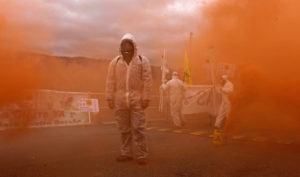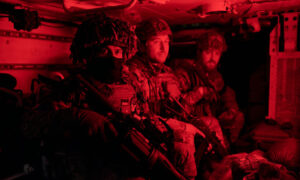When a four-ship Russian flotilla sailed into the port of Havana on Wednesday, US authorities were quick to downplay the event’s significance. We were reminded that Russia’s deployments were part of routine naval activity and that it’s not uncommon for the Russian Navy to sail warships into the Western hemisphere. “Nothing to see here,” went the memo.
And yet, these are clearly not ordinary times, and this was no ordinary convoy. The flotilla that arrived in Cuba was the largest in years. It includes the guided-missile frigate Admiral Gorshkov, one of the Russian Navy’s most modern ships, armed with hypersonic missiles, and the nuclear-powered cruise missile submarine Kazan, one of the most advanced Russian submarines in service today — and the first-ever submarine of this kind to be deployed to a foreign port. On their way to Cuba, moreover, the four Russian vessels conducted “high-precision missile weapons” training in the Atlantic Ocean, which involved firing missiles at mock enemy targets from a distance of more than 370 miles. The Russian ships are expected to remain in the region throughout the summer for a series of planned military exercises in the Caribbean, and to possibly stop in Venezuela.
As “routine” as this deployment may be, the symbolism of a Russian nuclear-powered — and nuclear-capable — submarine gliding above water just 90 miles from Florida wasn’t lost on anyone. American authorities have previously described these submarines as being “capable of presenting “a persistent proximate threat to the US homeland”. “The warships are a reminder to Washington that it is unpleasant when an adversary meddles in your near abroad,” Benjamin Gedan, director of the Latin America programme at the Washington, DC-based Wilson Center think tank, told AP, referring to Western involvement in Russia’s war in Ukraine.
Though this is not yet a second Cuban missile crisis — officials from Cuba, Russia and the United States have been at pains to clarify that no nuclear weapons are deployed on either the Kazan or the Admiral Gorshkov — it’s hard not to see this as a Russian response to the recent intensification of the US-Nato proxy war against Russia. Over the past few weeks, the US and several other Nato countries have, for the first time, formally authorised Ukraine to use Western-supplied long-range weapons — and even Western F-16s — to attack Russian territory, which Ukraine promptly proceeded to do. Meanwhile, Ukraine conducted, almost certainly with Western approval, long-range drone strikes on two Russian radar stations that are part of the country’s early-warning radar system designed to detect incoming intercontinental nuclear missiles. Various Nato countries, most notably France, have also begun openly talking of sending troops to Ukraine.
In response to the West allowing Ukraine to use their weapons against targets on the Russian territory, Putin warned that Russia was considering doing the same — that is, providing long-range weapons to allied countries to strike Western targets. He responded: “If someone thinks it is possible to supply such weapons to a war zone to attack our territory and create problems for us, why don’t we have the right to supply weapons of the same class to regions of the world where there will be strikes on sensitive facilities of those countries?” Russia has also begun, for the first time since the invasion, a series of nuclear drills involving tactical nuclear weapons, including exercises in Belarus, which last year agreed to host Russian tactical nuclear weapons, with explicit statements that this is a response to “provocative statements and threats of certain Western officials regarding the Russian Federation”.
Speaking at the St Petersburg International Economic Forum, which took place last week, Putin clarified that he currently sees no threat to Russia’s sovereignty that would warrant the use of nuclear weapons. However, he reiterated that Russia would retaliate if someone threatened the sovereignty and territorial integrity of the Russian state — which, from Russia’s perspective, includes Crimea and the Donbas. He also used the opportunity to remind the world that many of Russia’s tactical nuclear weapons contained 70-75 kilotons of explosive power — around five times the size of the US nuclear bomb dropped on Hiroshima in August 1945.
You would think that such statements, coupled with Russia’s exercises involving tactical nuclear weapons, would at the very least give pause to Western leaders, not only in Europe, but in the US as well — especially in light of Russia’s beefed-up presence right off the American coast. Yet, it has become commonplace in Western circles to dismiss Russia’s nuclear threats as mere ruses. “Time to call Putin’s bluff,” declared former Republican Congressman Adam Kinzinger in an article in CNN last month. Meanwhile, retired general Philip Breedlove, former ambassador Michael McFaul, Stanford professor Francis Fukuyama and dozens of former US officials wrote in a letter to the White House that Russia’s threats were “demonstrably empty” — and that the US should simply ignore them.
Just the other day, Nato Secretary General Jens Stoltenberg, shrugged off Putin’s warning, saying “this is nothing new”. The argument is that since Russia has not responded to US provocations in the past, Nato can keep crossing Russia’s “red lines” without consequences. But this forgets something important. There are very good reasons why Putin has so far avoided using nuclear weapons and, in general, responding to Western escalation in kind: after all, if Putin had chosen to respond more aggressively to Western provocations, he would have offered Nato the justification to directly enter into the conflict, with potentially unimaginable consequences. Instead, Putin opted for a low-intensity war of attrition in which Russia clearly had the upper hand, given its advantage in manpower and its ability to produce more artillery and ammunitions than Ukraine and the West combined — the reason Russia is winning the war.
However, this does not mean that Putin is bluffing this time. To the contrary, evolutions in the rhetoric, capabilities and posture underpinning Russian nuclear threats — the greater emphasis on tactical nuclear weapons in military planning and an apparent lowering of the barriers to their use — “indicate that Moscow is slowly but surely working to undermine strategic stability and increase the credibility of its threats”, as Giles David Arceneaux, a fellow at the United States Air Force Academy, recently wrote. The risk of nuclear escalation is low but “very real”, he added. Indeed, insofar as Russia’s relative restraint in the face of Western escalation continues to be interpreted by Nato as a sign that it can continue to escalate with impunity, it seems reasonable to assume that at some point Russia may be compelled take action to restore deterrence credibility.
So, why are Western leaders so confidently discounting the possibility of nuclear escalation? One possible explanation is that the current Western leadership is simply lacking the intellectual, strategic and moral sophistication that characterised policymakers during the Cold War. Back then, it was understood that any scenario that entails a non-zero chance of the other side using nuclear weapons should be avoided at all costs — and that, therefore, when it comes to nuclear weapons, you don’t bluff and you don’t assume that the other side is bluffing.
Today’s Western leadership, defined by a volatile and fickle blend of ignorance, hubris, moral nihilism and desperation, seems to have forgotten these basic tenets. And coupled with the Western elites’ obsession with holding on to a hegemonic order that no longer exists, this has resulted in such a detachment from reality that some are still making the argument that the West must “unambiguously endorse Ukraine’s war objectives”, including “total territorial reconstitution back to the nation’s 1991 borders” — a scenario that would almost certainly result in Russia’s recourse to tactical nuclear weapons. It’s almost as if such analysts are deliberately trying to provoke Putin into doing this — perhaps believing it will turn Russia into a pariah state and result in a geopolitical win for the West.
Such considerations have probably informed Russia’s reluctance to pursue such action. But in the face of constant Western escalation, how long will Putin be able to resist the growing calls for a strong response coming from the more hawkish factions of Russia’s foreign policy circles? A senior member of an influential Russian think tank, for example, recently suggested that Moscow consider a “demonstrative” nuclear explosion to cow the West into refusing to allow Ukraine to use its arms against targets inside Russia. “To confirm the seriousness of Russia’s intentions and to convince our opponents of Moscow’s readiness to escalate, it is worth considering a demonstrative (i.e., non-combat) nuclear explosion,” its director Dmitry Suslov wrote in the business magazine Profil.
No doubt Western leaders will publicly claim that this is yet another bluff. But what if they’re wrong? Have we really reached the point where a mushroom cloud is needed to puncture our complacency?
Disclaimer
Some of the posts we share are controversial and we do not necessarily agree with them in the whole extend. Sometimes we agree with the content or part of it but we do not agree with the narration or language. Nevertheless we find them somehow interesting, valuable and/or informative or we share them, because we strongly believe in freedom of speech, free press and journalism. We strongly encourage you to have a critical approach to all the content, do your own research and analysis to build your own opinion.
We would be glad to have your feedback.
Source: UnHerd Read the original article here: https://unherd.com/



